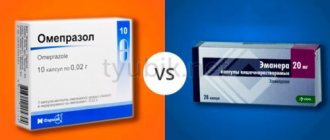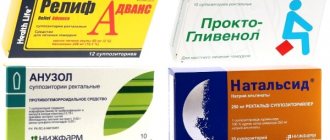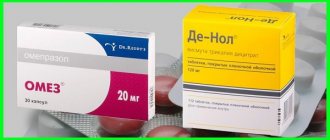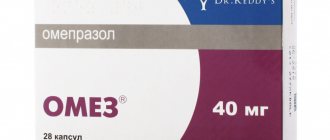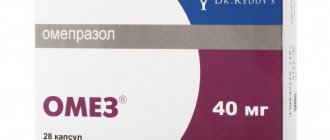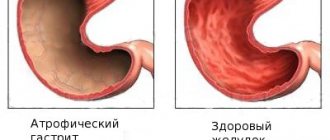What is Omez?
Omez is an active pharmacological drug, the substance of which is omeprazole, used in gastroenterology to treat stomach diseases. It belongs to the pharmacological group of antiulcer drugs, as it reduces the production of hydrochloric acid (HCl) in the stomach and its aggressive effect on the gastrointestinal tract. The mechanism of action is associated with inhibition of the proton pump, which is responsible for the production of gastric juice. Omez is also active against the bacterium Helicobacter pylori, which infects in the acidic environment of the stomach.
Its indications for use:
- stomach and duodenal ulcers;
- damage to the esophagus by stomach acid (erosive esophagitis);
- heartburn (gastroesophageal reflux disease (GERD)).
Note!
To eradicate (destruct) Helicobacter pylori, an integrated approach to treatment is mainly used, which involves the use of antibiotics and omeprazoles, so such treatment should be carried out by a doctor.
What you need to know before you start taking Omez
If you have an allergic reaction to Omez or to other omeprazole drugs - esomeprazole, lansoprazole, pantoprazole, rabeprazole, then you should stop using this drug and its derivatives.
There are also certain health conditions in which taking Omez is undesirable, since the general health of a potential patient undergoing therapy with this drug may worsen:
- respiratory dysfunction (shortness of breath);
- kidney problems (renal failure);
- osteoporosis (decreased bone mass density) - prolonged use of Omez can lead to osteopenia (decreased number of osteocytes - bone cells), as a result of which the risk of fractures may increase;
- thick, tarry diarrhea, coffee-ground-like vomiting mixed with blood - this may be a sign of gastrointestinal cancer, and treatment with Omez may make it difficult to make a correct diagnosis;
- heartburn that does not go away for more than 12 weeks, or heartburn that is accompanied by wheezing;
- liver problems (liver failure);
- unreasonable loss of body weight;
- reduced amount of magnesium in the blood (hypomagnesemia).
Be careful!
Omez is prohibited for use if you are pregnant or planning a child, and it should not be taken during lactation. A doctor's consultation is required.
Omez is prohibited for children under 6 years of age weighing less than 20 kg.
How to take Omez?
Omez is available in the form of capsules and powder for the preparation of a suspension for oral administration.
Omez capsules should be taken in the morning on an empty stomach at least 20 minutes before meals.
Omez in powder form is dissolved with a small amount of water, shaken thoroughly until the particles are completely dispersed (dissolved). After which it is immediately consumed orally or through a nasogastric tube (a special tube that is inserted through the nasal cavity and further along the esophagus, going straight into the stomach) using a syringe with a catheter.
When using Omez suspension, always use the measuring cup that is included in the drug packaging. It is not recommended to use ordinary cutlery to avoid dose deviations.
Note!
Omez can be used continuously for 2 weeks, after which there must be a break of at least 4 months before you start a new 2-week intake of this drug.
Directions for use and dosage of Omez
The doctor prescribes the dosage of Omez individually for each patient, depending on his state of health, age and specific type of disease.
Note!
Omez may be prescribed to protect the gastrointestinal tract during treatment with drugs from the group of non-steroidal anti-inflammatory drugs (NSAIDs), since the latter can cause ulcerative lesions of the stomach and intestines, and can also lead to internal bleeding of the gastrointestinal tract. The general name for such a negative effect of NSAIDs on the gastrointestinal tract is called NSAID gastropathy.
In the presence of NSAID gastropathy:
Omez is prescribed at a dose of 20 mg once a day, for more advanced diseases - 40 mg. The course of treatment is determined by the doctor depending on the severity of the disease. On average it can last from 2 to 8 weeks.
For tumors (gastrinoma) of the gastrointestinal tract (Zollinger-Ellison syndrome):
Used at a dosage of 60 mg once a day. The dose may be increased by the attending physician if necessary.
For eradication (eradication) of Helicobacter pylori:
Depending on the severity of the disease, the dosage varies from 20 mg to 40 mg per day.
Note!
As a rule, when treating against H. pylori, complex treatment is used, which involves the prescription of Omez and specific types of antibiotics. Therefore, if the stomach is colonized (spread of pathogenic microflora in the organs) with H. pylori, the treatment must be strictly determined by the doctor.
To prevent relapses (recurrences) of peptic ulcer:
10 mg 1 time per day.
For renal failure:
10-20 mg per day. The maximum daily dose should not be higher than 20 mg.
For liver dysfunction and for the elderly:
No specific dose adjustment is required. It is determined by the doctor depending on the type of disease.
Omez Insta
Omez ® Insta
(lat.
Omez Insta
) - an antiulcer drug that reduces acidity in the upper gastrointestinal tract with a complex mechanism of action:
- decrease in the production of hydrochloric acid in the parietal cells of the stomach, for which the active substance Omeza Insta omeprazole, which is a proton pump inhibitor, is responsible
- chemical neutralization of acid in the esophagus and stomach, which occurs due to the relatively large amount of sodium bicarbonate
(synonyms
sodium bicarbonate
,
baking soda
,
baking soda
).
Omez Insta is a variant of the drug Omez, characterized in that its composition, among the excipients, contains a large amount of sodium bicarbonate. Therefore, the pharmacological and other properties of Omez Insta are largely determined by the characteristics of the active substance Omez - they are set out in the article “Omeprazole”. Baking soda (sodium bicarbonate) is an absorbable antacid that provides rapid acid reduction after consumption. However, a serious disadvantage of baking soda, like other absorbable antacids, is the short duration of action, acid rebound (increased secretion of hydrochloric acid after the end of the drug's effect), the formation of carbon dioxide during their reaction with hydrochloric acid, which stretches the stomach and stimulates gastroesophageal refluxes (Bordin D.S. .). In the figure on the right: a schematic representation of the mechanism of action of Omez Insta (omeprazole/sodium bicarbonate) (O.A. Sablin, A.A. Ledovskaya).
Composition and dosage form of Omez Insta
Omez Insta is available in powder form for the preparation of a suspension for oral administration. One sachet of Omez Insta contains:
- formally the only active ingredient is omeprazole - 20 mg
- Excipients:
- sodium bicarbonate - 1,680 mg
- xylitol - 2 g
- sucralose - 30 mg
- sucrose - 2.7 g
- xanthan gum - 55 mg
- mint flavoring – 30 mg
Indications for use of Omez Insta
Omez Insta is indicated for the treatment and prevention of the following diseases and conditions and relief of the following symptoms:
- heartburn and other symptoms characteristic of gastroesophageal reflux disease
- non-erosive and erosive forms of GERD
- eradication of Helicobacter pylori
in patients with gastric and/or duodenal ulcers (if necessary and strictly as part of combination therapy) - conditions and diseases of the gastrointestinal tract during therapy with non-steroidal anti-inflammatory drugs
- conditions caused by acid hypersecretion: Zollinger-Ellison syndrome, stress ulcers of the gastrointestinal tract, polyendocrine adenomatosis, systemic mastocytosis.
Method of use of Omez Insta and dose
The contents of the Omez Insta sachet immediately before use (half an hour before meals) are poured into a vessel, one or two tablespoons of water are added, thoroughly stirred until a homogeneous suspension is obtained and immediately drunk.
It is acceptable to drink a small amount of water. Other liquids for dissolving Omez Insta are not allowed. Dosage and duration of use of Omez Insta:
- for quick relief of heartburn - a single dose of Omez Insta packet
- for non-erosive GERD - one sachet once a day for 4 weeks
- for erosive GERD - one sachet twice a day for 4–8 weeks, depending on the severity of esophagitis
- to prevent exacerbation of reflux esophagitis - one sachet once a day, the duration of maintenance therapy is determined individually
- in case of exacerbation of a stomach or duodenal ulcer not associated with Helicobacter pylori
- one sachet in the morning once a day for 4-8 weeks - to eradicate Helicobacter pylori,
therapy is used in various combinations: for 7–14 days, omeprazole 20 mg, amoxicillin 1 g, clarithromycin 500 mg - twice a day; or omeprazole 20 mg, clarithromycin 500 mg, metronidazole 500 mg - twice a day; or omeprazole 20 mg twice a day, bismuth preparations at a dose of 120 mg 4 times a day, metronidazole 500 mg three times a day and tetracycline 500 mg 4 times a day (see for more details Standards for the diagnosis and treatment of acid-dependent and associated with Helicobacter pylori diseases) - for the prevention of gastric or duodenal ulcers - one sachet in the morning once a day for 4-8 weeks
- for the treatment of NSAID gastropathy - one sachet twice a day for 4-6 weeks, for prevention - one sachet per day for the period of NSAID use in patients with risk factors for the development of NSAID gastropathy
- for hypersecretory conditions - one sachet in the morning once a day for 4–8 weeks
- in the treatment of Zollinger-Ellison syndrome, doses are selected individually, depending on the clinical condition. The recommended starting dose is 3 sachets per day. In most patients, the condition is adequately controlled in the dosage range of one to six sachets. If it is necessary to use a dose of more than 4 sachets, it must be divided into two doses
- in elderly patients and with renal failure there is no need to adjust the dose
- in case of liver failure, a daily dose of one sachet per day may be sufficient.
pH-grams of the esophagus and stomach after taking Omez Insta
On pH-grams in the body of the stomach with a single dose of a Omez Insta packet, in most cases, an almost immediate increase in pH and the development of a plateau at the level of 4-5 pH units was recorded, and then a further increase in pH over 30-60 minutes to a level of 6.0 –6.5 pH units. The dynamics of intraesophageal pH after taking Omez Insta in most patients was characterized by the disappearance of episodes of pH acidification (Sablin O.A., Ledovskaya A.A.).
Daily pH gram of a patient with GERD before (A) and against the background (B) of a single dose of one Omez Insta sachet (marked with an arrow). Designations:
- “Body of the stomach” - pH gram of the body of the stomach
- “Esophagus 5 cm” - pH gram at a point in the esophagus located 5 cm above the lower esophageal sphincter
- “Esophagus 20 cm” - pH gram at a point in the esophagus located 20 cm above the lower esophageal sphincter (Sablin O.A., Ledovskaya A.A.)
Daily pH-gram of the body of the stomach (upper graphs) and esophagus (lower graphs) of a patient with GERD after taking Omez Insta, pantoprazole and rabeprazole
(from the report of I.G. Pakhomova at the 18th International Medical Slavic-Baltic Scientific Forum “St. Petersburg–Gastro-2016”)
General information
Omez Insta is a prescription medicine
.
Instructions for medical use of the drug Omez Insta (powder for the preparation of suspension for oral administration, 20 mg), (pdf, ).
According to the pharmacological index, Omez Insta belongs to the group “Proton pump inhibitors”. For ATC - to the group “Proton pump inhibitors”, code “A02BC01 Omeprazole”. In the USA and some other countries (but not in Russia), Zegerid, which, like Omez Insta, contains omeprazole and sodium bicarbonate, is approved for use.
In Russia, three more drugs with similar names and similar (but not identical) pharmaceutical effects are approved for use:
- “Omez” is “pure” omeprazole, which, unlike Omez Insta, does not contain sodium bicarbonate
- "Omez D" and "Omez D" are combination drugs containing, in addition to omeprazole, the prokinetic drug domperidone
Manufacturer of Omeza Insta:
Dr. Reddy's Laboratories Ltd., India.
Materials for healthcare professionals regarding the use of Omez Insta in the treatment of the gastrointestinal tract
Articles and abstracts of reports
- Yakovenko E.P., Ivanov A.N., Yakovenko A.V. and others. Proton pump inhibitors: new opportunities for individual selection of therapy in patients with gastroesophageal reflux disease // Attending physician. 2012. No. 6.
- Sablin O.A. Ledovskaya A.A. New possibilities for antisecretory therapy of gastroesophageal reflux disease // Experimental and clinical gastroenterology. 2012. No. 6.
- Sholomitskaya I.A., Kapralov N.V. Proton pump inhibitor “Omez Insta” in the treatment of acid-related diseases // Medical news. – 2012. – No. 10. pp. 73-76.
- Sholomitskaya I.A., Kapralov N.V., Polyanskaya A.V. Efficacy of Omez insta, an immediate-release proton pump inhibitor // Sat. abstracts “XXXIX session “Multidisciplinary approach to gastroenterological problems”. 2013. March 5–6. P. 30.
- Kapralov N.V., Sholomitskaya I.A., Polyanskaya A.V. Comparative effectiveness of acid-inhibiting agents in treatment. night acid breakthrough // Sat. abstracts “XXXIX session “Multidisciplinary approach to gastroenterological problems”. 2013. March 5–6. P. 30.
- Bulgakov S.A. The phenomenon of nocturnal acid breakthrough during treatment with proton pump inhibitors and its therapeutic correction // Pharmateka. 2012. No. 13.
- Simanenkov V.I., Zakharova N.V., Tikhonov S.V. and others. Efficacy and safety of an immediate-release proton pump inhibitor for gastroesophageal reflux disease: results of the INST-PERSPECTIVE study // Attending physician. 2014. No. 8. p. 8.
On the website GastroScan.ru in the “Literature” section there is a subsection “Omeprazole”, containing articles for healthcare professionals discussing the treatment of diseases of the gastrointestinal tract with omeprazole.
Video
Still from video Vovk E.I.
Medicines for the treatment of heartburn and diseases associated with hyperacidity. Clinical pharmacology On the website GastroScan.ru in the “Video” section there is a subsection for patients “Popular Gastroenterology” and subsections “For doctors” and “For medical students and residents”, containing video recordings of reports, lectures, webinars in various areas of gastroenterology for healthcare professionals and medical students.
Omez Insta has contraindications, side effects and application features. Consultation with a specialist is necessary. Back to section
What should you not do while taking Omez?
Before taking Omez, you should consult your doctor if you are taking other medications to treat any other diseases, in order to eliminate the risk of unwanted drug interactions and negative effects on the body as a result.
Omez may cause diarrhea, which may be a sign of a new infection. If you have watery or bloody diarrhea, you should tell your doctor before taking antidiarrheal medications.
Which is better in quality, Ranitidine or Omez
Currently, Omez is used in clinical practice when it is necessary to reduce stomach acidity. Its high efficiency, ease of use, low price and low incidence of side effects make it a leader even among drugs with similar effects.
Indications for the use of Ranitidine are limited. Often it is a reserve drug for use in combination with other drugs to control nighttime symptoms. It is also prescribed for repeated ineffective use of PPIs, the presence of individual intolerance to Omez and contraindications to its use.
The main thing to remember is that before self-prescribing any drug, you must consult a specialist. After all, only a complete examination and analysis of the disease history will help you use the correct drug treatment.
What are the side effects of Omez?
The main side effects of Omez include:
- cold symptoms such as nasal congestion, sneezing, sore throat, fever (especially in children);
- abdominal pain, flatulence (gas);
- nausea, vomiting, diarrhea;
- headache.
Infrequent side effects of Omez with long-term use include:
- weakness and pathological fatigue in the muscles (myasthenia gravis);
- pain in muscle tissue (myalgia);
- joint pain (arthralgia);
- decrease in blood cells (thrombocytopenia, leukopenia);
- increased levels of liver enzymes (alanine aminotransferase (ALT), aspartate aminotransferase (AST));
- ulcerative lesions of the oral mucosa (stomatitis);
- increased sensitivity to sunlight (photosensitivity).
Along with the necessary effects, Omez can cause some complicated , undesirable effects , the manifestation of which requires seeking help from a medical specialist :
- severe abdominal pain, watery or bloody diarrhea;
- new or unusual joint pain;
- convulsions;
- fever, rash, nausea, loss of appetite, joint pain, scanty urination, blood in the urine, weight gain - these symptoms indicate kidney problems;
- hypomagnesemia (low levels of magnesium in the blood), which includes symptoms such as dizziness, irregular heartbeat, feeling nervous, muscle cramps, coughing, or a feeling of choking;
- new or worsening lupus symptoms, such as joint pain and a skin rash on the cheeks or arms that gets worse with exposure to sunlight.
Note!
With very long-term use of Omez, conditions such as:
- benign tumor of the stomach (fundic gland polyp), which is accompanied by proliferation of the gastric mucosa;
- iron deficiency anemia (lack of vitamin cyanocobalamin (B12)) - due to the fact that Omez impairs the absorption of iron in the body.
Side effects
Omez is a potent drug and it changes the functioning of the gastrointestinal tract, therefore, with its long-term use, the following troubles may occur:
- constipation or diarrhea
- abdominal pain
- nausea, flatulence, vomiting
- taste disturbance
- dry mouth
Therefore, if a person taking Omez observes these manifestations, he should immediately stop taking the medication and consult a specialist.
In addition, there is such a thing as an overdose. If the patient experiences confusion, pain in the back of the head or tachycardia, this indicates an overdose of Omez. It is necessary to call emergency assistance in such cases.
Interaction of Omez with other drugs and substances
It is sometimes unsafe to take Omez at the same time as certain medications because some medications can affect the blood levels of others, which can increase side effects or make the medications less effective.
Among the drugs that may interact with Omez are the following:
- anticoagulants - Omez enhances their therapeutic effect;
- iron preparations - Omez impairs their absorption in the gastrointestinal tract;
- clarithromycin (antibiotic) - Omez increases its concentration in the blood;
- St. John's wort can reduce the concentration of Omez in the blood, thereby weakening the pharmacological effect of the latter;
- methotrexate (antitumor) - Omez increases its concentration in the blood plasma;
- ampicillin (antibiotic) - Omez impairs its absorption.
The above list of Omez interactions is not exhaustive. For more detailed information on Omez, it is recommended to consult a doctor.
Which is better to choose, Omez or Omeprazole?
Omez is a generic drug in which omeprazole is the main substance. According to randomized studies, the content of the active component in the original drug and its analogues may differ significantly.
For example, more auxiliary components are added to generics: sucrose, titanium dioxide, sodium hydrogen phosphate, etc. Therefore, their maximum concentration in the blood plasma is observed after a longer period of time, and the elimination of all components occurs faster. The main advantage of such drugs is their low cost in comparison with original drugs.
However, the use of Omeprozole analogues in clinical practice proves their effectiveness. Both the original drug and its analogue quickly penetrate the gastric mucosa, after which they are adsorbed into the bloodstream and reach maximum concentration in plasma within an hour.
- Omez is not an original drug, but an analogue. Its main difference is a slightly slower increase in the concentration of the active substance in the blood plasma and accelerated excretion from the body.
- The main advantage of the drug is its budget cost.
These representatives of proton pump inhibitors can be used not only to treat gastrointestinal diseases, but also to protect its walls during long-term use of non-steroidal anti-inflammatory drugs. The fact is that the latter have an irritating effect on the walls of the stomach, which can lead to the formation of erosions and ulcers.
What you need to know about the drug Omez
Omez must be taken under the strict guidance of a doctor, observing the dosage regimen and especially the duration of use, since a prolonged decrease in hydrochloric acid in the stomach can lead to the development of a new infection in the gastrointestinal tract (for example, salmonellosis, colitis). Omez also impairs the absorption in the stomach of the beneficial B vitamin - B12, which comes from the outside along with the food consumed. During long-term therapy with Omez, it is recommended to monitor the state of bone health, since Omez can lead to osteoporosis.
It is also worth knowing that Omez is not intended to quickly eliminate the symptoms of heartburn - antacid medications are better suited for this.
Remember that it is important to store Omez out of sight and reach of children, at room temperature, away from light, excess heat and moisture.
